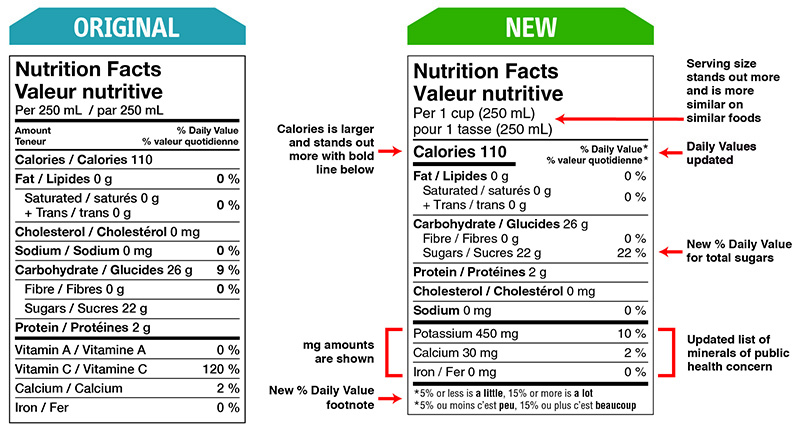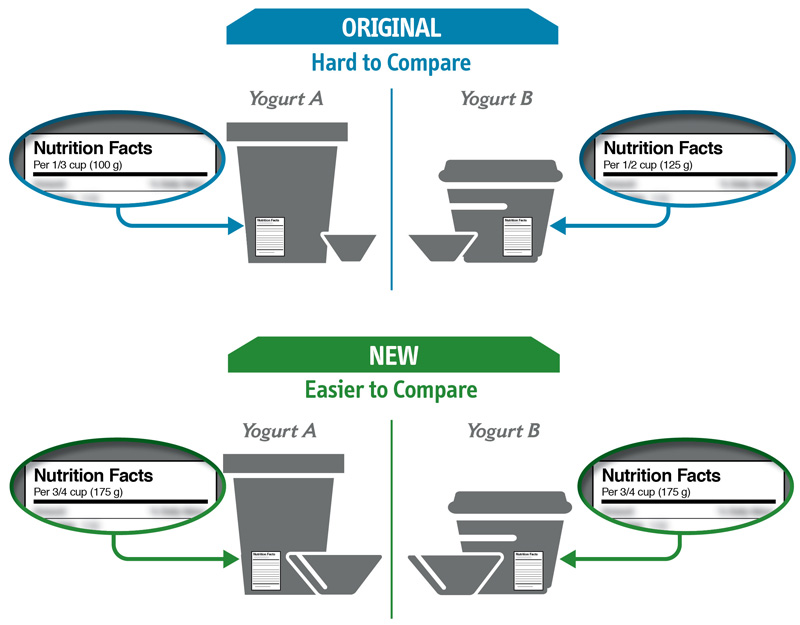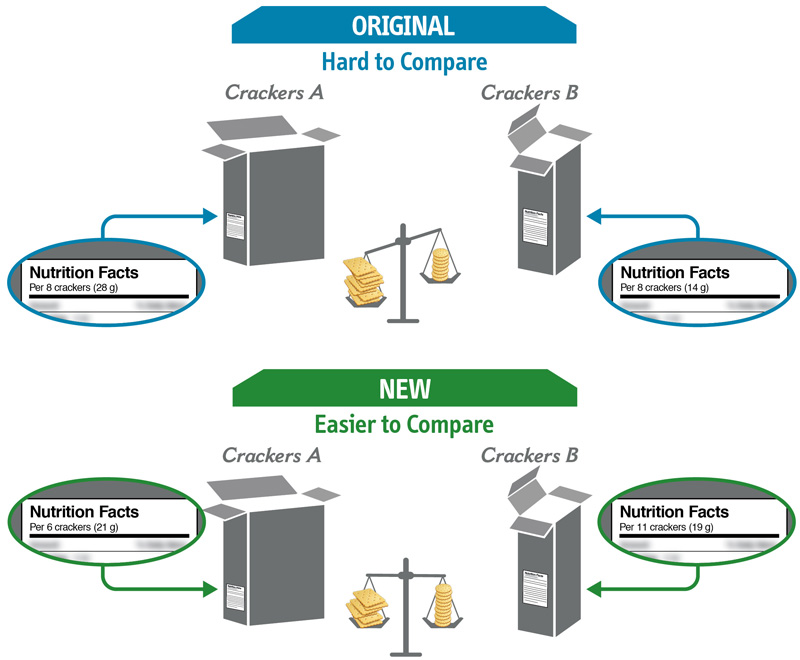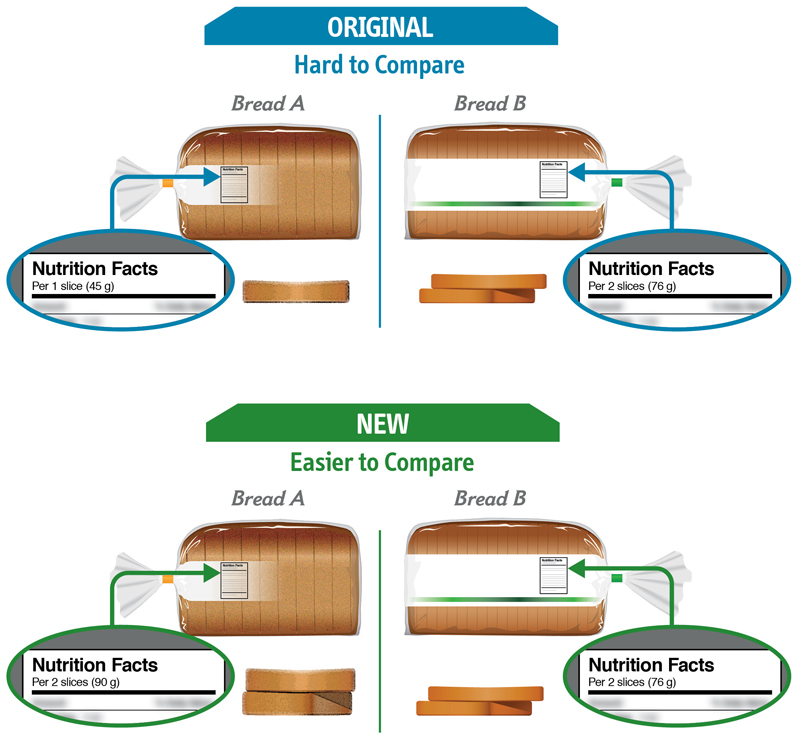Understanding the government's changes coming in December of 2022.
12/07/21
Food labeling changes
As of December 15th, 2022 the government of Canada will be making improvements to the nutrition facts table and the list of ingredients on food labels. These changes will improve the nutrition facts table and the list of ingredients to make them easier to understand and help Canadians make more informed choices. Here is a simple guide to understanding these new changes.
Nutrition facts table
The government of Canada has made the following changes to the nutrition facts table:
- The serving size is more consistent so that it’s easier to compare similar foods and more
realistic so that it reflects the true amount that Canadians typically eat in one sitting. - The information about the serving size and calorie count is easier to find and read
because of the increased font size and a bold line under the calories. - The % daily values based on updated science have been revised.
- There is a new % daily value for total sugars.
- The list of nutrients has been updated to include potassium, vitamin A and vitamin C have been removed as most Canadians already get enough of these in their diet.
- The amounts in milligrams (mg) for potassium, calcium, and iron have been added.
- Consumers will be able to find a footnote at the bottom of the table about the “% daily value” which will help consumers understand how much sugar and other nutrients like sodium are in their food. It also explains that 5% or less is a little and 15% or more is a lot.
Figure 1. Nutrition Facts Table Changes.
List of ingredients
There have been many new changes to the list of ingredients on food packaging. Some of these new changes include:
- Grouping sugars-based ingredients in brackets after the name ‘sugars’. This will help
consumers identify all of the sources of sugars added to the food. - Listing food colours by their individual common names, making the text in black font on
white or neutral background so it is easy to read. - Creating minimum font height requirements for ingredients to help consumers read the
information properly. - Lists will now have bullets or commas to separate ingredients, using both upper and lower case letters for the ingredients in the list. The same format rules will apply to any ‘contains’ statement indicating the presence or potential presence of priority food allergens, gluten sources, and added sulfites.
These changes will make it easier to find, read and understand the list of ingredients for consumers.
Serving size
Changes to the serving size will better reflect the true amount that Canadians eat in one sitting. The serving sizes will now be based on regulated reference amounts. Serving sizes will also be more consistent which will make it easier to compare similar foods and know how many calories and nutrients are being consumed. The changes are different for single-serve and multi-serving packages.
For food in single-serving containers, containing up to 200% of the reference amount for that food, the serving size will be the amount of the whole container.
Figure 2. Foods in single-serving containers.
For food in multi-serve packages, serving sizes will be in an amount as close as possible to the food’s reference amount. For multi-serve packages, serving sizes are based on the type of food, such as food that can be measured, food that comes in pieces or can be divided, and the amounts of food that are typically eaten. These factors help the food industry make serving sizes more consistent for similar foods.
Figure 3. Foods that can be measured.
Figure 4. Foods that come in pieces or are divided.
Figure 5. Amounts of foods that are typically eaten.
Sugars information
The changes to the sugars information can be found in the nutrition facts table and the list of ingredients.
For the nutrition facts table, a % daily value has been included for total sugars to help consumers compare the sugars content of different foods, and identify sugary foods that should be limited, such as those with a sugars daily value of 15% or more. An example of this would be comparing the sugar % daily value for milk (13%) and chocolate milk (26%).
Figure 6. Sugars information.
For the list of ingredients, sugars-based ingredients have been grouped in brackets in descending order by weight after the name ‘sugars’ to help consumers see that sugars have been added to the food. Enabling them to quickly find the sources of sugars added to the food, and understand how much sugars are added to the food compared to other ingredients. Sugars can include white sugar, beet sugar, raw sugar or brown sugar, agave syrup, honey, maple syrup, barley malt extract or fancy molasses, fructose, glucose, glucose-fructose (also known as high fructose corn syrup), maltose, sucrose, or dextrose, and fruit juice concentrates and purées concentrates that are added to replace sugars in foods.
Figure 7. List of ingredients: sugars.
Additional information
There have been many new and exciting changes to Canada’s food labeling, helping consumers make more informed choices for their diet. For additional information please visit the Government of Canada website: https://www.canada.ca/en/health-canada/services/food-labelling-changes.html#a4
